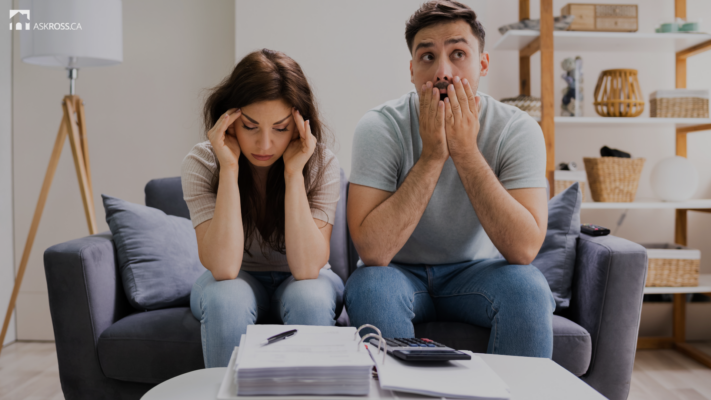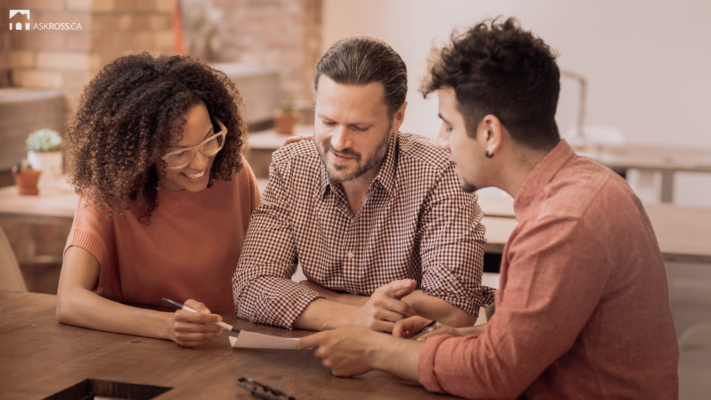
Published: July 12th, 2024 • Last Updated: September 20th, 2024
Author: Ross Taylor on AskRoss.ca
How a Bridge Mortgage Can Help You
Moving from one home to another can be tricky, especially when the sale of your old home and the purchase of your new one don’t line up perfectly. Many homeowners find themselves navigating this timing challenge, which often leads to unexpected financial and logistical hurdles.
In these scenarios, a bridge mortgage can be a lifeline. This type of loan provides the necessary funds for a short period—typically three months to a year—to bridge the gap between the closing dates of your two real estate transactions. It’s a solution that’s generally available only when you have a signed, unconditional offer on your current home.
If you’re caught in this kind of transition, a bridge mortgage could be exactly what you need to smooth things over. Let’s delve into how this financial solution works and how it can help you manage the complexities of coordinating your home sales and purchases.

1. What is a Bridge Mortgage (Financing)?
A bridge mortgage is when you get approved for a regular mortgage for the new property you are buying, PLUS short-term financing (mortgage) to cover your down payment and closing costs until your current home sells. This financing option or temporary mortgage is the bridge mortgage. It essentially helps you “bridge” the gap between when your first home is sold and your new home purchase is complete. This is why the solution is called a bridge mortgage.
If you have not yet sold your home, hopefully, this is because you chose to do so, or you simply were not able to match up the dates. If you have a firm sale date for the home you are living in, this situation is usually very manageable, and not stressful. A regular bridge mortgage will allow you a smooth transition between your real estate transactions.
Let’s explore the reasons why you might need a bridge mortgage and the various approaches to addressing the situation. We polled several Canadian mortgage industry veterans and their comments can be found in this article.

2. What is The Average Cost for a Bridge Mortgage?
Due to the nature of bridge mortgages, financing is only needed for a short while and it is not that expensive. You should prepare for a possible setup fee (or administration fee), as well as the interest expense on the money borrowed. Some lenders register a mortgage charge on both properties and that costs money too.
With financial institutions like banks and other A-lenders, the setup fee typically ranges from $0 to $1,000.
- The interest rate on these bridge mortgages is often the Bank Prime rate plus 4% to 5%. Prime is 6.95% today, (June 6, 2024) so we are talking abouta bridge mortgage interest rate between 10.95% and 11.95%. We are expecting the Prime rate to decrease in the coming months, and the bridge mortgage interest rates will decrease accordingly.
- Suppose you needed a bridge for $150,000, the daily interest cost would be between $45 and $49.11
- A one-month bridge would cost between $1,350 and $1,522 in interest costs.
- If you need more money, you can adjust these numbers upwards proportionately. For example, if you need a bridge mortgage of $250,000 you would multiply the costs by $250,000 / $150,000.

3. Why Homeowners Want a Bridge Mortgage
When transitioning between homes, many homeowners face the dilemma of timing their sale and purchase perfectly. A bridge mortgage can provide a seamless solution, offering financial flexibility during this interim period. Here are some key reasons why homeowners might consider securing a bridge mortgage:
- You want time to deep clean your new home. During the pandemic, we all became more attentive to germs, etc. Spending the time and money on a deep clean gives you peace of mind that you are doing everything possible to curb the spread of COVID-19 and its variants.
- You want time to do some renovations or touch-ups to the new property prior to moving in. Rarely is a home picture perfect. Suppose your plan is to renovate the bathrooms, rip up the floors or finish the basement, it will be easier when the house is empty, as opposed to when it is fully furnished, and you are living in it.
- You commit to the home purchase before you have actually sold the home you are living in. The need for a bridge mortgage arises more often in hot real estate markets where you must be aggressive when trying to win in a multi-offer situation.
- You want to use the equity from the bridge mortgage as a down payment. The bridge mortgage allows you to use the equity gained from selling your old home for the down payment for your new home even when the closing dates do not match.

4. Reasons Why a Bridge Mortgage Loan May NOT Be Right For You
That being said, Wes Sudsbury points out “bridge financing makes your move far less stressful for your family and your lawyer. Getting keys at 3 pm or 4 pm, after having to be out of your home by 9 am or 10 am, is tough on everybody.”
- There are higher interest rates: There are typically higher interest rates on bridge short-term loans vs. a conventional loan, by around four to five percent. The best practice is to work to keep the dates you are bridging as close together as possible (sale/purchase completion).
- Potential fees: You may incur a setup fee and legal fees to register the charge.
- Comprehensive Paperwork: There is a lot of paperwork and underlying work that will need to be completed for a bridge mortgage. Luckily the work is mainly for the lenders, not the borrowers.
Fortunately, there are many lenders who will offer you mortgage financing which will bridge the time between the two closing dates. This is called “bridge mortgage financing”.

5. Bridge Mortgages – What to do when your current home has a firm sale date?
Now what if you do not have a firm buyer lined up? This means you are in line to own two properties for the foreseeable future. Can your finances handle the strain of the repayment of your first mortgage while managing mortgage payments on the new property?
J.D. Smythe points out you cannot bridge this way without a firm sale agreement. The lender most likely to consider and approve your bridge mortgage request is the same lender who has approved the long-term financing on your new home. You should not expect a different financial institution to provide you with a bridge mortgage, no matter how much you think they love you.
No one really enjoys processing a bridge mortgage – but it is a necessary and important product offering for the banks because it paves the way to a larger, meaningful home financing solution.

6. Private Bridge Mortgages – What to do when your current home has not sold yet?
If your current home has not sold yet, you’ll need to find a private bridge mortgage solution. If you do not, and if you don’t have the cash flow to complete the purchase of your new home, you may end up in a breach of contract situation. But, if you have no offer in hand before the completion of your purchase, then hopefully there is enough equity to source a bridge mortgage from private lenders.
Reaza Ali says to make sure to ask detailed questions of whoever you’re considering dealing with (i.e. setup fees, lender fees, discharge fees, appraisal requirements, legal fees, and the fee schedule in general)
For example, Fisgard Mortgages offers a bridge product that is reasonable, generally priced with a mortgage rate range between 10.99%-11.99%, with a lender fee range between 0%-1.5%, depending on the specific scenario. They do take security on both properties until the current property sells.

7. Warning Labels for Bridge Mortgages
Most B-lenders do not offer this type of financing. If your current mortgage is being arranged with a B-lender, you want to avoid a mismatch of closing dates if at all possible.
Some buyers do not require a mortgage at all once their current home sells. But in that case, your bank may be reluctant to go through the hassle and expense of arranging a bridge mortgage for you.
- Nancy Ingram says the solution, in this case, may be to put a Home Equity Line of Credit (HELOC) on the new purchase. Everyone is satisfied, and the borrower always has access to emergency funds if needed, but the balance can be paid off on the sale so they don’t have a debt if they don’t want it.
- Sky Sorenson points out life is easier if the same lawyer is handling the sale and the purchase.
- Elan Weintraub says “I tell clients that getting a bridge is like getting a second approval from a lender. So if the mortgage file is marginal a bridge may be declined.”
Key Takeaway
There are several different situations where bridge mortgage financing might be the right option for you. The cost and ability to access such financing can vary considerably and depends on your unique circumstances, as well as the lenders you are dealing with. Please be sure to ask us if this is the right strategy for you and we will take care of all the details.
Related Articles
- Mortgages 101 — What You Need To Know Before Applying For A Mortgage
- Top Ten Things Your Home Buying Budget Needs To Include (In Addition To The Purchase Price)
- Why You Need A Down Payment Strategy
- Mortgage Pre-approval In Canada. What It Is & How To Get It
- Mortgage Pre-approval FAQs
What banks offer bridge loans?
The Big Six banks, the term commonly used to describe the National Bank of Canada, Royal Bank of Canada, Bank of Montreal, Canadian Imperial Bank of Commerce, Bank of Nova Scotia (Scotiabank), and Toronto-Dominion Bank (TD) all offer bridge mortgages.
Many credit unions, smaller banks and other major mortgage lenders (like First National Financial and MCAP) also offer bridge mortgages. Most B-lenders do not offer bridge mortgage financing.
What is the average cost of a bridge loan?
Your cost depends on the size and complexity of your bridge mortgage request, and also the number of days you need this temporary financing. Assuming you are not sourcing the bridge mortgage from a private lender, an average home buyer typically spends $1,000 to $3,000 all-in.
The major banks do not typically charge a setup fee, while other lenders may.
And you may incur some legal fees to register the bridge mortgage.
For every $100,000 you bridge, the monthly interest will be between $535 and $600.
Can you get a bridge mortgage if you have bad credit?
Good credit will certainly help, and if you have bad or weak credit, you never know, it might be enough to deter your lender from offering you a bridge mortgage. If your primary mortgage lender turns down your application for a bridge loan, you may have to consider a more expensive private mortgage solution.

Ross Taylor
One of Toronto/GTA's Most Trusted and Knowledgable Mortgage Agents
Ross Taylor is recognized by his peers as one of Canada's pre-eminent difficult mortgage specialists. His ASKROSS blog and column in Canadian Mortgage Trends are focused on the intersection between mortgage financing and personal credit.
With unique dual certification as a licensed credit counselor and mortgage agent, Ross's insights are valued by mortgage professionals and homebuyers alike.
If you have questions about anything financial or mortgage-related, please contact [email protected]. Ross answers everyone personally.
For more information, visit About Ross Taylor.


 Apply For a Mortgage
Apply For a Mortgage